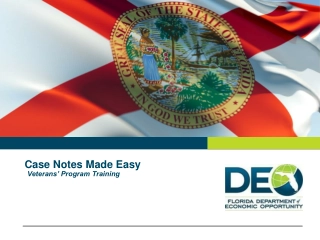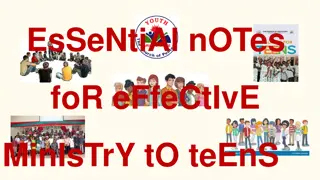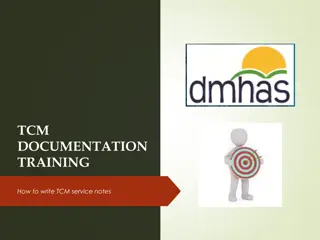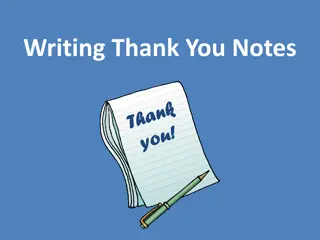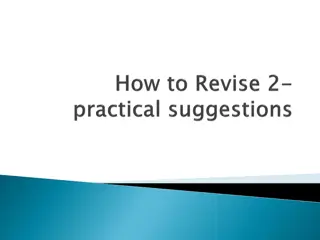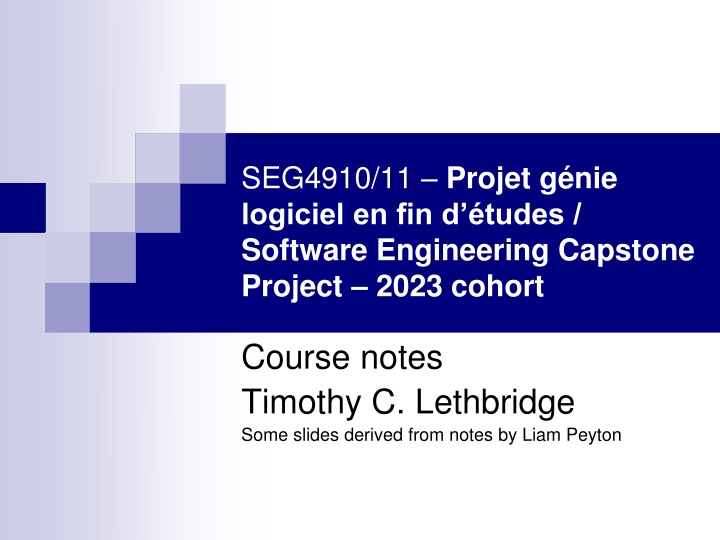
2023 Cohort Course Notes for Software Engineering Capstone Project
These course notes outline key information for the SEG4910/11 Software Engineering Capstone Project being led by Timothy C. Lethbridge. The notes cover course logistics, professor details, project guidelines, communication preferences, project requirements, team formation, workload expectations, and the unique structure of having one project spanning two courses. Students are provided with guidance on finding projects, forming teams, and working with customers throughout the project duration. With a focus on bilingual communication and online resources, the course aims to facilitate a comprehensive software engineering experience for the 2023 cohort.
Download Presentation

Please find below an Image/Link to download the presentation.
The content on the website is provided AS IS for your information and personal use only. It may not be sold, licensed, or shared on other websites without obtaining consent from the author. If you encounter any issues during the download, it is possible that the publisher has removed the file from their server.
You are allowed to download the files provided on this website for personal or commercial use, subject to the condition that they are used lawfully. All files are the property of their respective owners.
The content on the website is provided AS IS for your information and personal use only. It may not be sold, licensed, or shared on other websites without obtaining consent from the author.
E N D
Presentation Transcript
SEG4910/11 Projet gnie logiciel en fin d tudes / Software Engineering Capstone Project 2023 cohort Course notes Timothy C. Lethbridge Some slides derived from notes by Liam Peyton
Tim Lethbridge, Ph.D., P.Eng. Professor at Uottawa; full-time since 1994 Software Engineering Usability, software tools, knowledge engineering, code generation Former software developer at Nortel and the Government Researcher with GM, IBM, Boeing, Ericsson and smaller companies Current research focus: Model-Oriented Programming (Umple) and UX 2
Cours Bilingue . Vous pouvez travailler en fran ais Vous pouvez faire des pr sentations et les documents pour le projet en fran ais Vous pouvez poser ou r pondre aux questions en classe en fran ais En g n ral, je communiquerai en anglais car il y a des tudiants unilingues Mais si vous me posez une question en fran ais, je r pondrai en fran ais 3
Everythings online / Tout est en ligne Brightspace Videos of sessions / schedule Microsoft Teams Course announcements Chat / video with each team Website http://www.site.uottawa.ca/~tcl/seg4910-11/ Class schedule These notes (updated for Jan 2023) 4
Most of you have teams, some have finalized projects We have been working on projects for 2 months prior to the course If you don t have a project, see listings on Microsoft Teams Contact other students who say they are looking, and post your own name Email clients if a project is still available Direct message students and the prof 5
One Project 2 Courses 1 Project customer (meet regularly, once every week or two) Type 1: Customer has problem Type 2: Open market customer represents a user in the market Groups: 2-5 students (possible exceptions) Typically there is a group leader (can take turns) Workload: 3-4 weeks per person per semester (12 weeks at 12-15h/wk per student) Start in 4910, finish in 4911 Must have same project, same customer(s), same group for both courses, otherwise you have to retake the entire sequence 4910 / 4911 6
SEG4910 attends in the same time slots as SEG4911 SEG4911 students are finishing their project SEG4910 will learn from their presentations Only some timeslots will be used See the schedule to know when to attend 7
Team roles / Rles d'quipe Shared among students / Partag entre tudiants Project Manager Gestionnaire de projet Business Analyst Analyste d'affaires QA manager Responsable de l AQ Architect Architecte Build Manager Gestionnaire de build Lead Developers D veloppeurs principaux But everybody does some design and coding tout le monde fait du design et du codage 8
The Real Customer / Le vrai client Someone who wants to or would be willing to use the product after you have finished the project Quelqu'un qui veut ou serait pr t utiliser le produit une fois que vous avez termin le projet The customer follows the work from concept to deployment over 2 semesters Key to Agile approach The customer sees and comments on your work every week or so, hence is on site virtually 9
Deliverables to professor ASAP: In your Teams conversation (created when your team is formed) Project title and brief description to be approved by the prof Name and email of customer if you have not selected from the list of projects provided by the prof Week 2 of 4910: Github/Gitlab repo invitation or link posted to Teams conversation, then project initial overview in the Wiki Some leeway will be allowed for groups that show they are working hard on getting going by communicating to the prof 10
Deliverables to professor At week 7 and 12: Each individual posts a link in Teams to a URL listing their commits By week 7: Each individual has completed self- evaluation (Prof will send URL) End semester in 4910; mid semester in 4911: Presentation(s) End semester in 4911: Motivational demo Attending class most weeks (80%) according to schedule Ongoing. Commits; PRs; issues; Wiki updates 11
Project initial overview Must be finalized by SEG4910 week 2 on your wiki or Readme.md Outline Team members and their roles Objectives (benefit to customer, key things to accomplish, criteria for success) Expected/anticipated architecture Anticipated risks (engineering challenges, etc.) Legal and social issues. Initial plans for first release, tool setup, etc. Put the above on the Wiki and privately send me your customer s name, title and contact info Send by Team channel for your group if channel is set up 12
Example recent very successful projects (1/2) Machine learning from network data to detect malware (several) Making dev tools available on the web Managing sets of 3D printers Analyzing video of sports to automate stats (company started then more 491x) An app to help medical specialists diagnose strokes (used by patients and doctors) 13
Example recent very successful projects (2/2) App to help local farmers distribute produce directly to consumers Co-op navigator mobile app Math educational tool Crowdsourcing tool for legal cases (3 years) Generator of Swagger from software Airport information system Warehouse robot routing 14
Example recent causes of poor grades (1/4) Working full time at paid employment (sometimes not even letting teammates know) Writing trivial amounts of simple code Not struggling hard to solve a technical problem ( I tried is not enough in the capstone) Not searching effectively online for solutions or experimenting 15
Example recent causes of poor grades (2/4) Stopping work for weeks and blaming midterms Trying to catch up at week 8 (or week 10) Arguing with clients in an unprofessional way Not testing enough, so clients and the prof find too many problems Not trying out enough with real users Not polishing the product 16
Example recent causes of poor grades (3/4) Spending weeks trying to learn a language in depth (best to dive in and learn as you go) Trying to get away with letting team-mates do more than their fair share Not delivering what they have promised to teammates, on time Trying to do too much or too little, given team size 17
Example recent causes of poor grades (4/4) Making beautiful looking graphics only Not contacting the prof quickly enough when a problem starts to get out of hand Focusing on the business side of a startup, and not producing software Building something with little innovation Making something that won t realistically be able to attract any real users 18
Overall grading scheme Sch ma de notation global FINAL_MARK=(Default team grade * Complexity adjustment factor) + Individual factors NOTE_FINALE=(Note d' quipe par d faut * Facteur d'ajustement de la complexit ) + Facteurs individuels 19
Overall grading scheme Sch ma de notation global Complexity adjustment factor is usually 1.0 or close Le facteur d'ajustement de la complexit est g n ralement de 1,0 ou proche Individual factors are normally 0, but can be positive or negative Les facteurs individuels sont normalement 0, mais peuvent tre positifs ou n gatifs 20
Default team grade (out of 100) Note d' quipe par d faut (sur 100) (25%) Customer satisfaction / Satisfaction du client This is key / C'est la cl (20%) Professionalism and project management / Professionnalisme et gestion de projet (10%) Presentation/demo / Pr sentation/d mo (25%) Design (20%) Communication 21
Grades for customer satisfaction worth 25% (1/2) 5% Problem solved? 0= not at all; 1=partly; 2=considerably; 3=mostly; 4=almost fully; 5= fully; 6=exceeds expectations for quality; 7=exceeds expectations for quality and functionality 5% Their perception you have been working hard 5% Reaching out and meeting Has the whole team met, or tried to meet with customers regularly? Obtaining requirements, testing prototypes 22
Getting grades for customer satisfaction (2/2) 5% Have you listened to them Did you respond to customer input, including explaining why some things were not done? Have you adjusted the project to meet their needs, as the requirements change? 5% Concretely delivered 4910: Do you have a great prototype? 4911 (middle) Do you have a minimum viable product? 4911 (near end) Is the product on market or in production, with knowledge transfer? 23
Grades for design worth 25% Have you made design decisions that allow for flexibility, scaling, security and maintainability? Do you have good data schema and APIs Have you used the right frameworks? Is code written well? Does it work properly? Is the UX good (easy to learn, speedy response, has needed features, gives good feedback, etc.) Is there evidence of enough tests to prove it works in all reasonable cases? 24
Grades for professionalism and project management worth 20% Have you followed agile process with sprints, testing, etc. Have you managed the balance among schedule (fixed), scope (carefully and quality (must keep high)? Has your team collaborated well? Have you made steady progress including getting going quickly? Have you dealt with problems well? Have you avoided or dealt with any ethical problems? Have you interacted with the customer well? Have you stuck to a schedule that allows it to be in production and maintained by others at the end of semester 2? 25
Grades for communication worth 20% Do you have a good record of requirements at a basic level? Have you recorded meeting minutes and design decisions (on the wiki) Can the prof and others understand your architecture quickly? Is your code well commented? Have you participated in class discussion? 26
Complexity adjustment factor (multiplied by group grade; default 1.0) Rewards hard work + ensures you are not trying to get an easy ride on an overly-simple project 1.1-1.2: Exceptional complexity in some of: architecture, algorithms, number of features, lines of code, tests, UX challenges, technical challenges And good progress has been made Judged relative to team size 27
Complexity adjustment factor continued 1: Project seems the right size for a team with each student working 12-15h/week 0.7-0.99: Small size; not sufficiently challenging; not developed far enough <0.7: Trivial or considerably incomplete 28
Individual adjustment factors (added; normally zero) A. Up to +10 points: Exceptional individual work as judged by clients, teammates or professor. No more than 50% of team members may receive such marks B. Up to +10 points from team members who have had to work hard to make up for other members that have lost points from C and D below 29
Individual adjustment factors C. up to -15 points. Student is > 15 days late delivering critical promised work to the team with insufficient justification. Professor must be notified at 10-day point, and will impose penalty at 15-day point. D. up to -10 points. Quantity and quality of commits as assessed by the professor and TA are lower than expected of a 4th year student. 30
Individual adjustment factors E. -5 each. Missing/late individual deliverables to the prof (self-evaluation, URL with personal commits, absent from presentation, excess absence from class) F. -5. Failure to disclose ethical issues (e.g. conflict of interest, working full time) 31
Agile work Use a Git repository Github (preferred), Gitlab, Bitbucket. Give the prof and TA access Deliver tests with commits where possible Use issue tracking for all user stories, features and bugs Use a Wiki or text files in repo for requirements, design., Put meeting minutes, progress logs here Do not use non-repo files (e.g. Googhle docs) Use a group communication channel (Teams, or Slack) Set up automated building where possible Deliver in increments when commits are ready at intervals of no more than a month, starting in Week 5 at the latest Continuous integration Each person commits their changes and the build runs 32
Legal Issues Academic Fraud Using others work without acknowledgement Misrepresenting results, participation IP You own your work but can relinquish your ownership (companies may insist on this) Non-Disclosure Agreements Sometimes needed discuss with professor Paid-For Work I do NOT recommend it. You must discuss with me. All team members must be equal 33
Work schedule Schedule times each week to work with your team Use the timeslots when you are not attending class After the pandemic, you can use project room on STE 2nd floor I will need to sign a form to get you access 34
A real project driven through to completion (1) Your capstone should be in production by the time you are done Being used by the customer for a month or two at least Or on the market with several update cycles and some downloads With a plan for ongoing maintenance by somebody 35
A real project driven through to completion (2) This means Keep it small enough Focus on high-value requirements Ensure there is automated testing Ensure it is Maintainable Installable Flexible Usable, etc. 36
A real project driven through to completion (3) You will lose marks at the end if The project is sort of done but will likely be abandoned You only submit a functioning system at the very last minute without much chance for people to seriously use it and find new issues There can be exceptions for proof of concept work, but this must be pre-approved by me and the customer 37
Avoid blindly doing what customers say they want Many real requirements emerge in use and through usability testing Requirements ALWAYS change Ask multiple potential users and experts (including the profs and TAs) and follow their advice Use your creativity and inventiveness to make your project better and more flexible 38
Beware of architectures/ frameworks that make response time slow The modern web isn t always the best Fast response time is one of the most important qualities 39
Best Practices Address Root Causes Root Causes Best Practices Insufficient requirements Ambiguous communications Brittle architectures Overwhelming complexity Subjective assessment Undetected inconsistencies Poor testing Waterfall development Uncontrolled change Insufficient automation Develop iteratively using agile methods Manage requirements using agile methods Use component architectures and frameworks Model the software visually consider Umple Test driven development Version control with pull requests and review Continuous integration 40
Iterative Development Accelerates Risk Reduction R I S Waterfall Iterative K Iteration Iteration Iteration Iteration Iteration Iteration Iteration T I M E 41
Iterative Development Characteristics Critical risks are resolved before making large investments Initial iterations enable early user feedback Testing and integration are continuous Objective milestones provide short-term focus Progress is measured by assessing implementations Partial implementations can be deployed 42
Analysis & Iterative Development SCRUM (Ken Schwaber) http://www.scrumalliance.org/learn_about_scrum 2-4 week sprints (customer releasable), prioritized feature backlog See separate slide deck Extreme Programming (Ken Beck) 3 week iterations, tests and data created and agreed to by customer before coding begins 43
The Agile Manifesto http://agilemanifesto.org/principles.html Individuals and interactions over processes and tools Working software over comprehensive documentation Customer collaboration over contract negotiation Responding to change over following a plan 44
Design in an Agile Environment Some agile proponents downplay design But Design is not the same thing as documentation All the manifesto downplays is comprehensive documentation 45
How should design be expressed in an agile environment? What is the minimum the team needs to properly structure the next sprint? Use cases/stories & test cases UI sketches / storyboards Class diagrams APIs Non-obvious Architecture Elements: Components, layers, dependencies, patterns and mechanisms 46
Agile Design 2 All of the above for the current sprint only i.e. don t design much beyond the current sprint except the list of user stories (backlog) Update your design in each sprint As you tackle new user stories As you refactor Avoid recording design elements that can be rapidly found by looking in the code or using tools 47
Agile Design 3 What information will other software engineers need when they try to modify your software? All of the above plus: How is the code laid out? Readme files in each directory Headings at the top of each file Possibly: Package diagram with textual descriptions How to make anticipated types of changes Create a high-level developers guide for everything that can t be put on code 48
Agile Design 4 Beware of maintaining design elements that will have to be changed whenever code is changed Storyboards (put in old folder after use?) Use cases (perhaps just keep a list, not details after they are implemented?) UML diagrams (can they be generated from code or can you use a tool that generates code from diagrams such as Umple) 49
Agile Design 5 As you create or maintain a document (i.e. a wiki page) Ask yourself if the effort of creating and maintaining it is worth it? Will anyone actually read it (again)? Will the cost of deleting it or throwing out detail be more than the cost of not being able to find information? 50




